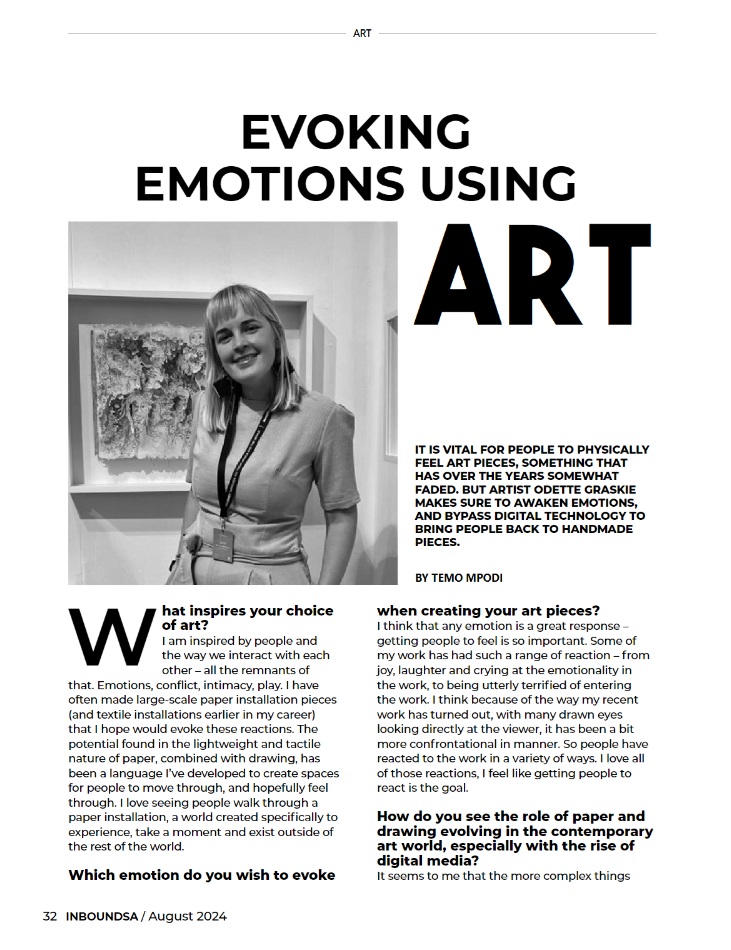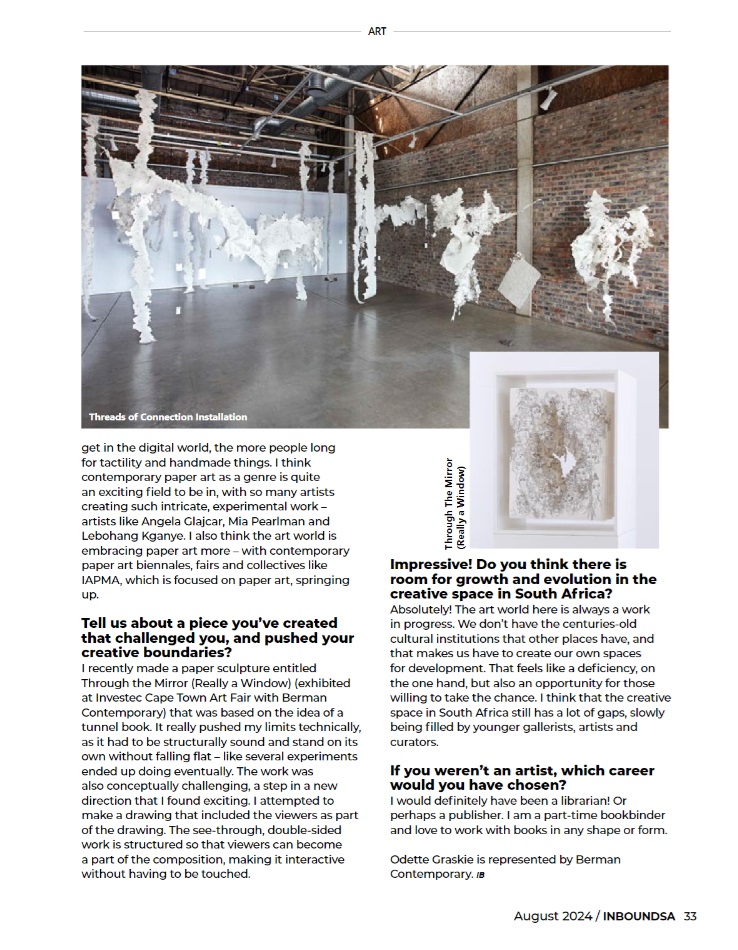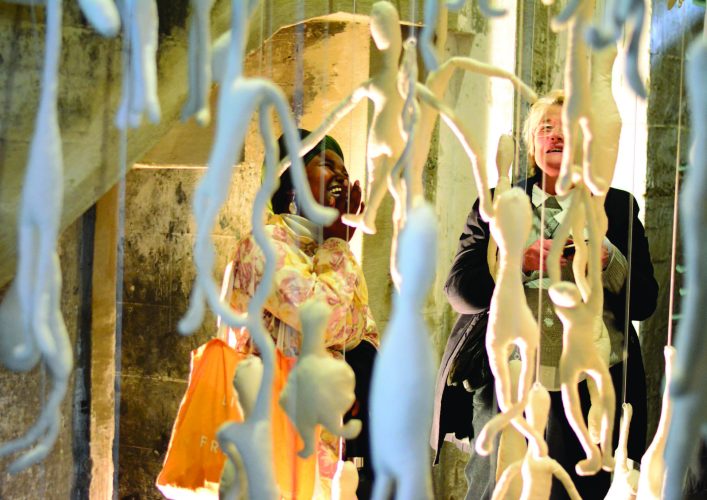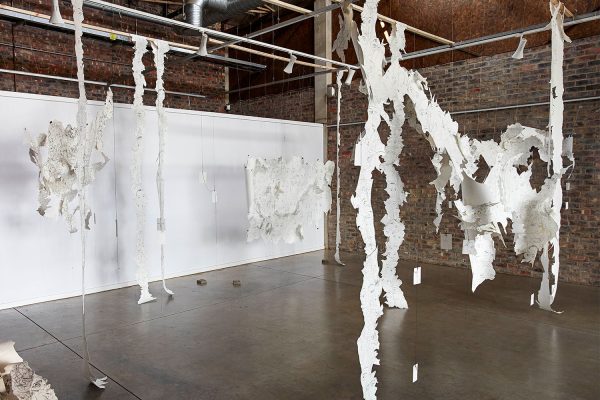The art of connection: Odette Graskie’s solo exhibition
‘Side Quest’ at Berman Contemporary
by Johannesburg in Your Pocket, November 2024
Evoking Emotions Using Art
by Temo Mpodi, for InboundSA Magazine, August 2024


Cape Town Art Fair 2024
Group booth, Berman Contemporary
a line
a thread
a conversation
a solo show by Odette Graskie
Sometimes a Pit in my Stomach, 2023

This artwork refers to the anxiety which sometimes accompanies my process, and creating these layers of drawing has been a translation of this anxiety into a material form. During the Drawing Sessions, I often have to reconsider my levels of social anxiety, and the ways in which this affects my drawing style. The relational drawing act isn’t just about me making portraits of sitters, it also is an exchange of emotions – and sometimes sitters project their nervousness about being drawn onto me. I find it difficult to shed the layers of anxiety in the moment, and find that drawing in the studio afterwards becomes a space for release. In Sometimes a Pit in my Stomach, I redrew the sitters into this structured artwork. Starting at the back, I created dense, intense drawings, and each new layer became less and less tense, ending with the top layer which only contains blind portrait drawings – the drawing style in which I am usually the most relaxed and free. This forms a sort of wound-like shape in the paper, but represents the ways in which stories and learning from my sitters can be healing despite the moments of anxiety in between. Interacting with sitters is a layered and complex act. This artwork is somewhere between being a paper sculpture or artist’s book. It involves all the parts of my process in a much more structured format than in my more organic wall sculptures and drawings.
Poem about my sketchbook
by Luke Davies

Artists Solidarity Assistance Project 2021
Please click on this image below to see the latest ASAP initiative from Candice Berman Gallery to support artists during the Covid-19 pandemic.
Artist Statement – Paper and Art
My artistic practice revolves around mystery, connection and moments of intimacy. It includes media such as drawing and an exploration of paper. By making my own, or discovering other handmade paper sheets, there is an embrace of the materiality of the page. My experiments with paper are attempts at maintaining the essence of the pages – the different textures along with the weightless fragility – while pushing the ways in which paper can be developed, entwined with my own hand and expression. Paper is a mode of connection, a way to tell stories through lifespans. In my artworks every face belongs to another, they are always connecting. I believe that human connection is healing and important when overcoming trauma.
My process comprises obsessive, labour-intensive drawing, cutting and putting pieces back together again. Drawing is a way of seeing, a way to connect with the world around me on a deeper level. Since a recent visit to Picasso and Paper at the Royal Academy in London, I have felt a renewed sense of the importance of drawing. By really looking at someone, even if I never see them again, I embrace the possibility of other existences outside of my own and find a way to connect with people.
In this, moments of humanity become possible even with characters on a page, with the touch of materiality and smell of moss, the presence of anthropomorphic forms. Healing is not only in conversation, it can be in one moment of pause and attention. In my work, stories are implied. Many hidden messages get lost along the way. In artist books, those might be literal words hidden in cracks and crevices, secret pockets and folded pages, forever lost to anyone who does not pay attention. Some artworks could contain poetry, others might be inspired by a book about plant biology, astronomy, secret libraries or space-time adventures. Faces are of those that have crossed my path, moments of intimate snippets taken, from people who might not have noticed me at all.
Youth Day Showcase Nedbank Collection
Residency at the Gatehouse Gallery in Guernsey

Article in The Guernsey Press written by Shaun Shackleton
Looking for Moss I
breathe in
collective sigh
stand still for a while
and smell the fresh of microscopic forest.
in this silent moment
we are reminded to look
open our eyes
take it in, it’s all that matters.
it’s not even a houseplant.
when we take it in, look close,
moss is only one part
of the click of a bicycle wheel
a flush of red on a cheek
someone’s defiant glance
the way the sun hits the morning grass.
it’s gestures,
sweetness on the tongue
bitter loss
in the eyes.
it’s a hand on a doorknob, years written on a face,
discarded tissue, gallery floors,
and a determined walking pace.
it’s lipstick passed along
the curl of a tail
spiderwebs blowing in the wind
until they turn to dust
accidental reflections, the smallness of the howl, ear-to-ear-laughter,
the tap of birds’ claws on corrugated sky,
worm’s steady crawl like shadow’s creep
through neverending mountains of green,
it’s the fraying of a person,
their softness,
their edges,
it’s seeing that a person is made up of many small moments
just like life is made up of many sketches,
it’s paying attention
it’s drawing
it’s a lesson we are learning
maybe it’s one we keep.
Artwork Features at RMB Starlight Classics
Residency at The Slade School of Art and Camden Arts Centre

I recently returned from the London Summer Intensive residency program at the Slade School of Art in cooperation with the Camden Arts Centre. This residency invited 24 artists to come make art at the Slade Woburn Square Studios for a four-week long intensive program. I met artists from all over the world, including another South African artist Joe Turpin. The program included a lot of networking with one-on-one sessions with local artists and curators, including Raju Rage, Andy Wicks and Matthew Krishanu. The residency is led by Jefford Horrigan, a funny and intelligent artist and London-enthusiast. He and his team of artists took us on tours along the Thames and gave intricate history lessons, as well as showed us some of the best pubs in London.
During the residency we were also taken on tours of London galleries, which included crit sessions with the curators at the Camden Arts Centre. A part of the residency included a work in progress exhibition at the Camden Arts Centre as well as a final exhibition at the Slade School of Arts. At the work-in-progress show I presented three hanging paper sculptures, assembled from different handmade papers I found at a local shop, with drawings I made of people from London. These were later combined and added to, to great one ghostly cloud-like shape. This was exhibited at the Slade School of Art Woburn Studios for the final open studios.
My means of drawing-collection included walks in local parks and public transportation, where I drew only faces. The diversity of London was very enriching, and I found myself drawing wildly differing people. This process made living in London, a place known for its lack of eye contact and interactions despite the proximity of people, quite intimate and rich. Looking and drawing strangers makes us really notice what is going on around us – a useful tool for someone trying to take in as much as they possibly can – but can have a violent side too.
Looking and drawing – taking a face (often without the participant’s awareness of what is happening) suddenly became a harsh endeavour. Redrawing them always changed the faces slightly – it changed the identity of the participant and made them into something else (do I create identity crises?). The final artwork also made me focus on the violent aspects of my process, and the way the off-white paper blowing in the wind became skeletal and quite eerie. The work in the end was gruesome when looked at in that way – something highlighted to me first by the curators at Camden. Thinking about my process as violent gave me a new perspective on my work and how it could be interpreted.
The uplifting aspect of the drawing process compared to the violence made for an interesting juxtaposition, while the addition of wind and movement laid focus on the thread. Thread has been a permanent fixture of my process, and having it become more of a feature and less of a practical necessity has also placed a focus on the way that it has become an extension of my line.
This residency has also been a motivation for me to start investing in paper and really looking at the type of pages I include in an artwork. Each sheet has a history – some made by hand, others by machines, each originating from plant life. My artwork also included a found object plant that I discovered on one of my walks, underneath a sign that said “Free Plants.” I made a small paper installation around the plant, and so the paper could return to its roots, while also pulling a random garden object into the gallery space.
Despite all these new avenues opened to me during this last month, I have many more questions than answers about the future of my work and where it will go. I feel energised to take on the next few months and really digest everything that has opened to me since the start of my time at the Slade School.
Interview with Artizens Blog:
Odette Graskie shares emotional experiences and storytelling through drawings and immersive fabric installation artworks.
Odette Graskie is a visual artist whose art aims to explore emotional experiences and storytelling. She aims to create work that celebrates humanity and the essence of being human, while facing everyday dilemmas such as grief and loss. Balancing this loss and making art about it is a process of healing, and focusing on the beauty of something beyond oneself becomes healing in itself. Her drawings and immersive installation artworks made with fabric are a fresh breath of air as you walk into a room. Her latest body of work, The Sorrows, is an exploration of the way that pain can sometimes be the only factor that reminds us that we are alive. We had the opportunity to learn a little more about her and her journey in the contemporary visual art industry.
Please click on the image below to be redirected to the Artizens Blog for the full article.
DekaTV Interview with Piet Matipa (Afrikaans)
Afrikaans Interview with Rooi Rose Magazine
July 2019

Turbine Art Fair Installations Program 2018
The Sorrows

Sorrow (n.)
(1) An unspoken intensity of feeling.
(2) A healthy ache that reminds you your body exists.
(3) A spark of transcendence that punctuates the flat-lining banality of everyday life.
I invite viewers to interact and participate with the Sorrows. These bodies are a dance of humanity, and each form contains its own possible story as it mingles with the others. They explore man’s existence in relation to forms that could be human too. The Sorrows are sometimes tragic and other times entirely silly. While one may look like he is doing a handstand, he might also be strung up by his feet. The work embodies the frail existence we all have as humans.
Afrikaans Interview with Vrouekeur Magazine
April 2018




Article by Ownetic about my Residency at the Baltic Centre for Contemporary Art 2017, Poland.
Please click on the image below to be redirected to the Ownetic website for the article.
Artist Statement for my Residency at the Baltic Centre for Contemporary Art 2017
When I arrived in the town of Ustka, it surprised me. No less than a place of holiday, of people on the beach, of sand and ice cream and litter in the beach. This place seemed like an overwhelming force of consumerism and human noise. But as David Foster Wallace points out, “If you really learn how to pay attention, then you will know there are other options. It will actually be within your power to experience a crowded, hot slow, consumer-hell type situation as not only meaningful, but sacred, on fire with the same force that made the stars: love, fellowship, the mystical oneness of things deep down.’
AS I explored Ustka, I thought about his words. Exploring Ustka has revealed a lot about the city to me, but also revealed a lot about myself that I did not know. When walking through the trees of the forest especially, I have found a version of myself that I would like to embrace. It is in between the trees and the dark shadows of their large canopies that I find a stillness from which my imagination goes out and becomes a wild creature.
It is in this stillness and in paying attention that the holiday resort that is Ustka, can become something more of a peaceful, fantastical occurrence in human nature – the need to breathe, to be like the trees and only breathe, standing still for a moment in time to become more or return to a former version of ourselves. We must be like the trees to find this person.
In my imagination, in this setting, trees can gain a strange life of their own. Who knows what sort of secret lives are found in the forests, in languages that we cannot even begin to understand? The trees themselves can gain a secret personality here, one that might even be stumbled upon in the night time or when they think no one is looking.
These towers that have seen so much more days than I have, they are the ones that enjoy true stillness. So I imagine my own story about them, and have created a city of trees. They are an immersive room filled with soft, friendly characters that each have a life of their own. You can see family resemblances between characters, and even a cluster of legs that emerge from an ever-changing mass of trees. I invite people to touch and interact with this world, and not fear or ignore it. Perhaps viewers can make their own stories of the trees. This work is made for interaction, for a co-operation between species and people and objects. I ask why we are afraid ot touch and listen to the sway of their branches.
Human Noise Artist Statement
“I could hear my heart beating. I could hear everyone’s heart. I could hear the human noise we sat there making, not one of us moving, not even when the room went dark.” – Raymond Carver
My textile artworks play with the idea of anthropomorphism as a tool to create an emotive response within viewers. The figures are presented as an attempt to anthropomorphise emotion, in identifying humanity in a psychological sense. Many of their shapes are not inspired by humans at all, but by shadows and trees passed by on a dark night, or waving in the wind in a strange and magical way. They beg for interaction with a viewer, and force it upon them, even if the viewer rejects interacting and tries not to look directly at them. I would like to confront viewers with uncertainty. Despite them not being alive, they have a human interaction with a viewer. They are form exploring man’s existence in relation to other forms that could be human too. Through this interaction they make the viewer the subject. The figures are suspended with string or rope displayed in a gymnastics of form.
My drawings also experiment with my need to detail and dot down encounters with other people, from strangers in the street to my closest relationships. Working with such drawing enhances my experience of a moment with someone and the awareness of that experienced moment. A moment wherein I am forced to look closer, is caught up and regurgitated onto paper endlessly in different compositions. In terms of textile art, I also see sewing as drawing, and line as the most important factor in my art process.
Human noise explores humanity and emotion, especially in terms of expression and the way that we tend not to be able to name our deepest encounters.
Human Noise because of an ever-lasting search for humanity in life around me. Human Noise because of the resonance, the wild layering of humanness that sounds in the air around us. Human Noise because of the ability to see human noise all around us. Human Noise because it screams out and drowns out everything but itself. Human Noise because of the fact that they aren’t human at all.
Artist’s Dictionary
Sonder
n. the realisation that a random passerby has a life as full and vivid as your own.
Kairos
n. the perfect, opportune moment.
Silience
n. the unnoticed brilliance that happens around us everyday.
Sillage
n. the trace left behind after a person has left – the scent, the footprints, the molecules
Anthropinization
n. resignation from human concerns.
Opia
n. the ambiguous intensity of eye contact
Zielschmerz
n. the exhilarating dread of finally pursuing a lifelong dream
Zenosyne
n. the sense that time keeps going faster
Occhiolism
n. the realisation of the smallness of your perspective.
Ambedo
n. a kind of melancholic trance in which you become completely absorbed in vivid sensory details
WYTAI
n. a feature of modern society that suddenly strikes you as absurd and grotesque
Aimonomia
n. fear that learning something’s name will somehow
ruin it.
Exulansis
n. the tendency to give up trying to talk about an experience because people are unable to relate to it
Vemödalen
n. the fear that everything has already been done






